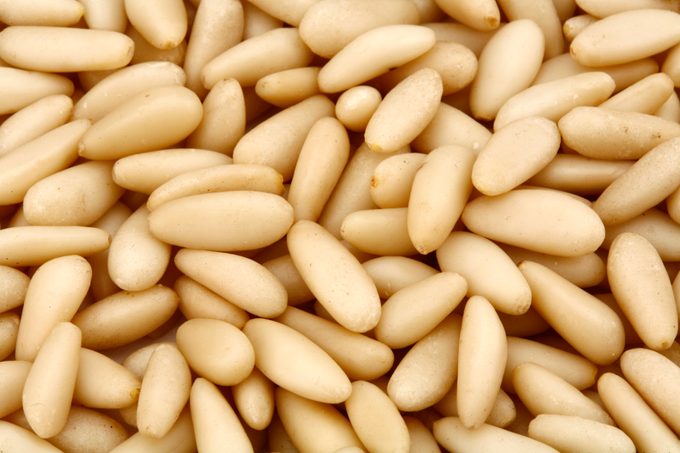You might be surprised to find out where pine nuts actually come from—and how they're technically classified

Where Do Pine Nuts Come From?

The beauty of food trivia is that there’s always something unexpected to discover. For example, eggplant is a fruit, not a vegetable. And peanuts aren’t actually nuts. You’re in for even more surprises when you start asking questions like “What are pine nuts, and where do pine nuts come from?”
The pine nut, of course, is the delicious star of one of our favorite foods: pesto. But are pine nuts actually nuts, and how, exactly, do they make their way to your kitchen? Keep reading for a handy guide to this mysterious food, from its surprising origins to why it’s so pricey.
Get Reader’s Digest’s Read Up newsletter for more food news, humor, travel, tech and fun facts all week long.
Where do pine nuts come from?
The funny thing about pine nuts is that they’re actually not nuts at all. Pine nuts (also called pignoli or piñón nuts) are the seeds of pine trees and can be commonly found in pine cones. According to Michigan State University, the pine nuts we buy usually come from stone pine and pinyon pine trees because they produce a larger seed that’s better for eating and easier to harvest.
Pine nuts can come from a number of pine trees, though, and aren’t limited to those two. Different pine trees grow in different areas of the country and even around the world, which means pine nuts are different depending on the region.
So where do pine nuts come from? They come from everywhere—as long as there is plenty of sunlight, well-drained sandy soil and pine trees growing there, of course.
Are pine nuts tree nuts?
Pine nuts are strikingly similar to peanuts in that they’re not tree nuts—or even nuts.
According to Anaphylaxis U.K., people who are allergic to tree nuts aren’t usually allergic to pine nuts, and vice versa, because they belong to different classifications. However, this isn’t a hard-and-fast rule, as food allergies can vary from person to person. If you’re allergic to tree nuts, proceed with caution with pine nuts, just in case.
Why are pine nuts so expensive?
If you’ve ever shopped for pine nuts, you probably know that they come with a hefty price tag. While tree nuts also tend to be expensive, pine nuts are in the upper echelon of the pricing scale. This is because they’re not easy to harvest.
A few factors affect this. For one, pine trees aren’t necessarily densely populated trees. Plus, getting the pine nuts from the trees and pine cones is a labor-intensive process. Add to this the fact that it takes a pine tree more than a decade to start to produce pine cones and pine nuts, and you’ve got yourself a long and arduous process that comes with a price tag to match.
Moreover, harvesting usually occurs in rough terrain, as mature cones must be harvested by hand, dried in the sun and then opened so that the seeds can be extracted. The harvesting season is short, and only certain species of pine bear edible, tasty seeds. All of these elements, along with a high international demand, especially for use in pesto or gourmet salads, make pine nuts expensive year-round.
When and how are pine nuts harvested?

Harvesting pine nuts is not a quick process. It takes pine cones many months to grow the seeds that become pine nuts. And even then, the pine nuts aren’t ready to be harvested before the pine cones fully bloom.
To speed up this process, pine nut harvesters place the pine cones in burlap sacks and leave them out in the sun. This makes the extraction of the pine nuts slightly easier. The fun part of the process is smashing the pine cones to get the pine nuts out!
FAQs
Are there any health benefits associated with pine nuts?
Yes, pine nuts are nutritional powerhouses. They contain healthy monounsaturated fats and are good sources of protein, magnesium and vitamin E. They also contain beneficial antioxidants and pinolenic acid, which aid in reducing inflammation, protecting heart function and, in some cases, suppressing appetite.
How do you store pine nuts so that they do not spoil?
Pine nuts have a high oil content, which makes them turn rancid quickly unless kept in appropriate conditions. You should ideally store them in an airtight container in the refrigerator for short-term use or in the freezer for longer storage. Always sniff for any “off” smells before using.
Can you substitute another of your favorite nuts or seeds for pine nuts in recipes?
Yes, if you’re not a fan of these pseudo nuts, you can use other nuts instead. Widely used substitutes include cashews, almonds, walnuts, sunflower seeds and even pumpkin seeds—especially in pesto. Love pine nuts? You can use them in place of other nuts or seeds.
Why trust us
At Reader’s Digest, we’re committed to producing high-quality content by writers with expertise and experience in their field in consultation with relevant, qualified experts. We rely on reputable primary sources, including government and professional organizations and academic institutions as well as our writers’ personal experiences where appropriate. We verify all facts and data, back them with credible sourcing and revisit them over time to ensure they remain accurate and up to date. Read more about our team, our contributors and our editorial policies.
Sources:
- Michigan State University: “Growing edible pine nuts in Michigan”
- Anaphylaxis U.K.: “Pine Nuts”
- Today: “Why are pine nuts so expensive? 4 reasons a small bag costs so much”
- Precision Nutrition: “Pine Nuts”
- World Atlas: “Where do pine nuts come from?”
- MasterClass: “A Complete Guide to Pine Nuts”























